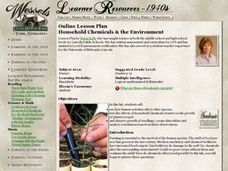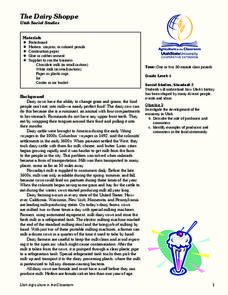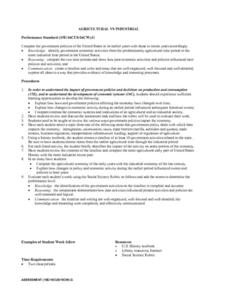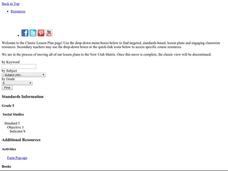Curated OER
LET YOUR FINGERS DO THE WALKING
The student will recognize different information sources. 2. The student will use a telephone book as a resource for locating agricultural businesses
and people with agriculture-related jobs.Discuss the purpose of the phone book, and...
Curated OER
Clothesline Sleuth
Students explore the make up of fabrics. In this agriculture lesson, students examine the cotton and wool crops of the United States and discover how fabrics are created.
Curated OER
A Common Thread: The Significance of Wool In Midieval England
Sixth graders fill in a KWL chart and participate in a simulation of role playing about the Renaissance. In this Renaissance lesson plan, 6th graders learn how agriculture affected the culture of Midieval England.
Curated OER
Foiling Spoilage
In this agricultural education worksheet, students read 6 descriptions of bacteria that cause food spoilage. Students then read 4 descriptions of preservatives that can be used to prevent spoilage. The worksheet is meant as a...
Curated OER
What to do with Malus-domestica, Cultivated Apples?
High schoolers take on the roles of apple farmers. In this Arizona agriculture lesson, students explore the concepts of supply and demand as they role play apple farmers who create marketing campaigns when supply outweighs demand.
Curated OER
Not Only a Drought
Young scholars explore the events that occurred during the Dust Bowl and differentiate between the good and bad agricultural practices. In this Dust Bowl lesson students participate in activities that shows them how to be good...
Curated OER
Double Trouble?
Students investigate cloned meat and animal products. In this food safety lesson, students research the noted Web sites in search of information about cloning and food labelling. Students use their findings to create informative...
Curated OER
Household Chemicals & the Environment
High schoolers conduct a laboratory experiment designed to investigate the effects of chemicals, soil quality and pollution on seed growth and plant yield. They consider how best to maximize agriculture in the long term.
Curated OER
Farmers and the Food Connection
Students investigate the process of growing food. In this agricultural lesson, students invite a farmer into their classroom to discuss how they grow and process food. Students participate in learning centers which focus on farming.
Curated OER
Farm Spiral Puzzle Worksheet
In this farm words learning exercise, learners read ten clues about agriculture and farm science. Students use their answers to fill in a spiral word puzzle. There is no word bank.
Curated OER
Cute Calves of Just Tasty Steaks
Students examine the state of agriculture. In this animal husbandry activity, students visit selected Web sites to research data on people's changing diets, farming practices, and animal health care.
Curated OER
Wheat: From Field to Oven
How does wheat go from the seed to the table? While focusing on main ideas and supporting statements, class members read an excerpt about wheat production and complete a worksheet. The end goal is a display that shows the different...
Curated OER
The Dairy Shoppe
Fifth graders research dairy farming and learn about dairy products as well as dairy processing. In this dairy instructional activity, 5th graders read background information about dairy farming and processing. Students discuss running a...
Curated OER
Let’s Make Cottage Cheese
Students watch the process of making cottage cheese from milk, then season and taste the product. In this making cottage cheese instructional activity, students make a connection between what they eat and where it came from. ...
Curated OER
Making Pretzels
Students discover that plants provide food products to humans. In this baking lesson, students grind wheat seeds into flour and then use the flour to make pretzels. Students participate in a variety of activities that involve them in...
Curated OER
Oklahoma Grown: Discovering Oklahoma's Agriculture
Fourth graders investigate where Oklahoma's variety of crops are harvested, and grown their own plants. A printable map and crop information guide are provided.
Curated OER
Symbiosis: Help, Hinder or Destroy
Use background information and vocabulary to familiarize your students with the concept of symbiosis and the role agriculture plays in the shared relationship. They then write the vocabulary in their lab books or journals, and read the...
Curated OER
Agricultural and Industrial Policies of the U.S.
Students examine the impact of laws and government policies on the agricultural and industrial economic systems. From a list of topics, they select one area and create timelines of at least ten related government activities. In...
Curated OER
Kansas Crops: From Seeds to Food
First graders explore U.S. geography by researching food production. In this agriculture lesson, 1st graders identify the process of crops from a seed to a plate and discuss the importance of farmers in the production of such crops....
Curated OER
Transporting Agricultural Commodities
Pupils propose packaging and handling needs for a specific product, then evaluate the documentation necessary for exporting and importing.
Curated OER
Where Does It Come From?
Fifth graders explore free trade. In this free trade instructional activity, 5th graders discover which commonly found products are made in the United States and which originate from other countries. Students explore which countries are...
Curated OER
Corn An A-Maizing Plant
Fifth graders consider the uses of corn. In this agricultural lesson plan, 5th graders examine corn as a natural resource and discuss the many ways to reuse the grain. A variety of activities, books, and web resources are...
Agriculture in the Classroom
Growing a Nation: Into a New Millennium 1970-Present
If you want to focus on critical thinking skills, this well-constructed series of activities will challenge your history or agriculture class to evaluate the effectiveness of administrative decisions related to agricultural and the...
Curated OER
Make a Farm
After a class discussion about where their food comes from learners construct a farm from a print-out (embedded in the plan). They work in groups, and trace a food source from the beginning. For example, they discover how a farmer grows...























